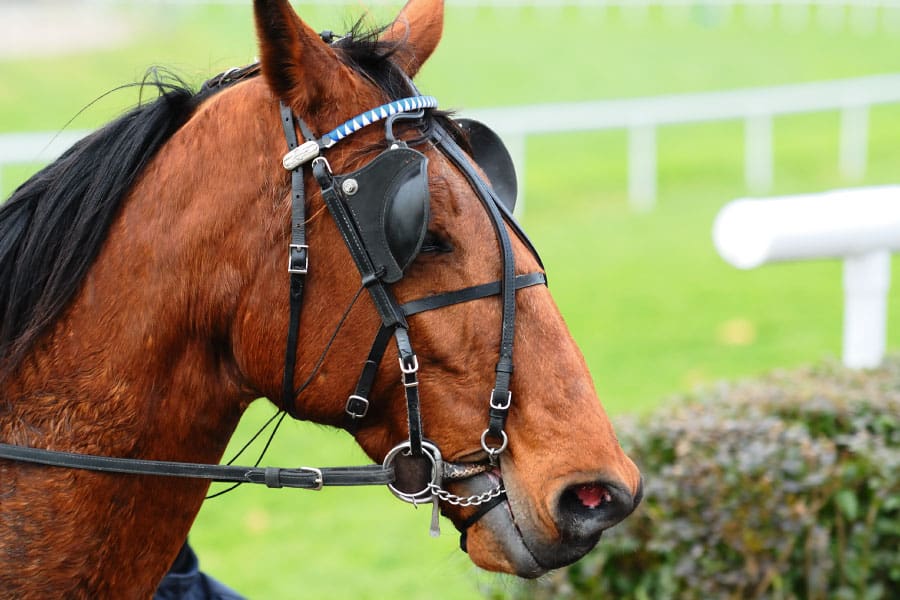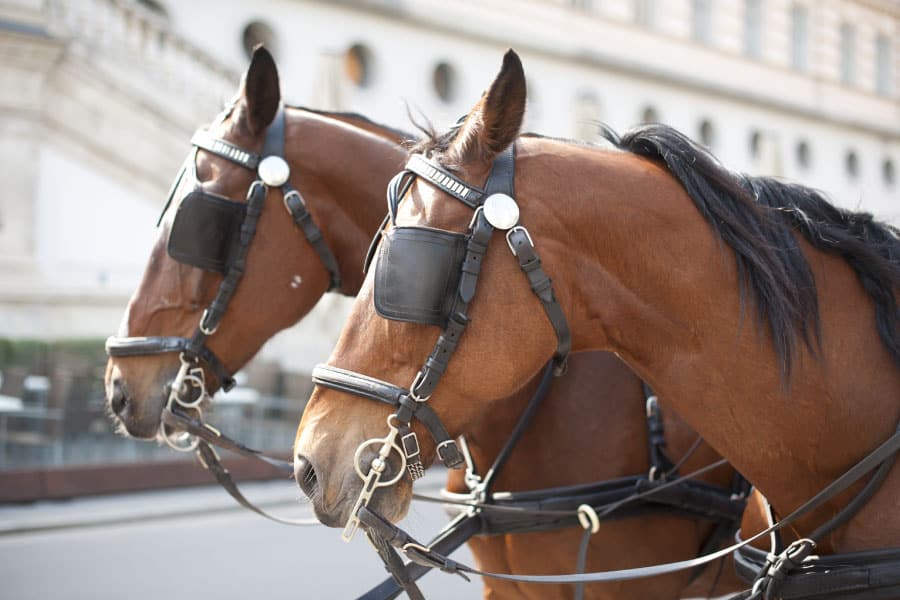- Your source for stall mats, rubber arena footing, arena harrows and arena dust control.

Blinders go by many names and may be interchangeably referred to as blinders, blinkers, winkers, or even shadow rolls. Blinders may be somewhat of a misnomer; the blinders do not blind a horse but rather restrict its field of vision. Traditionally blinders have been used extensively in carriage driving and racing.
Blinders are headgear used to reduce outside distractions. They help a horse stay calm and focused on their job. Horses have evolved as prey animals who choose to run away when faced with a threat. Blinders help horses by preventing them from seeing objects or events that may be perceived as a threat.
You may be wondering: Why would someone deliberately blind a horse, even temporarily? Does it help? Why do you need blinders? Can it be bad for horses to wear blinders? Hopefully, you will gain a greater understanding of why blinders are used and why blinders may produce the opposite effect than intended. Some horses go better without blinders; blinders can induce a stress response if not used appropriately.
What Are Blinders?
Blinders are leather, or plastic pieces of headgear, that are used to obscure and limit a horse’s field of vision. The blinders may be square with a slightly concave shape or circular. The height and depth of the blinders will differ dependent on the amount of vision to be restricted.
Leather blinders traditionally have a thin sheet of copper, which is hammered into a gently curved shape and covered with leather. These blinders are usually integrated into the bridle and directly attached to the broad, thick cheekpieces of the bridle. Leather blinders may be embellished with decorative stitching or metal emblems.
Marathon carriage drivers may opt for blinders made of rubber or plastic. These are lightweight and easily wiped down to remove mud and dirt after a fast day of driving.
Plastic, rubber, or vinyl blinders are worn as a part of a synthetic hood, often seen in horse racing. While they do not have the decorations of the leather blinders, they do come in a large variety of colors.
How Horses Have Adapted to Being Prey
A wild horses’ survival was dependent on quickly detecting a predator and then using instinctual reactions to run away. Being fast is good, but it does not guarantee survival. A fast horse would still make a good meal for a hungry lion if the horse did not notice the lion in time. Monocular vision and a highly sensitized stress response give the horse the time and energy needed to run away.
Horses have two large eyes on either side of their head, enabling a broad non-overlapping field of monocular vision. The price of this extended field of vision is a blind spot directly in front of the horse and another behind them. Horses’ eyes are excellent motion detectors but are not great at detecting details or determining distance.
The ability to react fast is due to the horse’s highly developed stress response. When a horse detects a possible threat, they do not have time for logic or reason. Instead, the amygdala and hypothalamus in the brain flood the horses’ body with the adrenalin needed to power a horse running for its life.
Horses have been man’s partner for centuries and despite humans selectively breeding horses to suit our purposes, millennia of survival instincts trump centuries of human-driven horse breeding. Like their ancestors, modern horses preferred method of escape is flight when they perceive a threat.

What is the Purpose of Blinders?
Historically, blinders have been reported to improve a horse’s concentration. Limiting the horse’s peripheral vision prevents them from seeing all the potentially scary things that may cause the horse to spook and run away.
It prevents the horse from becoming frightened of the carriage following him and any surrounding distractions in carriage driving. A harnessed horse that bolts are potentially lethal to itself, the carriage passengers, and bystanders. Carriage accidents are extremely dangerous, and all efforts to improve safety should be embraced.
In racing, blinders are used for much the same purpose as carriage driving; keeping the horse focused straight ahead and eliminating outside distractions. Racing horses may benefit from blinders for another reason as well.
Horses are social creatures who have complex social hierarchies. When racing, horses run in tightly clumped groups with relatively little space between each horse. It is the first time the horses will be encountering each other. A nervous horse may react defensively and try to move sideways to get away from his racing neighbor or lash out to protect himself. This will slow the horse down and can be dangerous for horses and jockeys.
Which Equestrian Sports Permit the Use of Blinders?
Blinders are mostly used in flat racing, steeplechasing, and carriage driving. The exception is heavyweight pulling competitions and rodeo or Calgary driving demonstrations. The use of blinders in other equestrian sport will result in immediate elimination.
Do All Horses Benefit From Wearing Blinders?
The short answer is no. A prey animal, like a horse, relies heavily on its vision to remain safe. Some horses may show an increased stress response if they cannot access their full field of vision. It is well known that horses blinded in one eye will be more easily frightened if approached on the blindside. Most blind horses will be humanely euthanized as they cannot adapt to a life without sight. Also, check out our post, “Can a One-eyed Horse Jump Too? ” for more on horse sight.
” for more on horse sight.
Blinders, winkers, and shadow rolls do not induce complete blindness when worn and are never worn permanently, but regardless of this, some horses will never be comfortable wearing them.
It is theorized that horses run faster and longer when wearing blinders because they cannot see the threat behind them. The horse can hear the sounds behind them, but they run faster to get away from the perceived danger because they cannot see the threat.
Many of the horses wearing blinders often over-race and win by many lengths. While this may initially seem like it is not a bad thing, it has a long-term cost. The more a horse exerts himself to win, the longer it will take him to recover for the next race, and the risk of injury is increased.
A respected horse driving trainer noted that in his early career, he used blinders on all his horses. He was then asked to put an experienced dressage horse into a harness. This horse was in his late teens about to embark on his second career. He was an obedient, calm horse with beautiful movement. He went through all the training required for carriage driving, but he remained stiff and tense. He was difficult and dangerous to drive.
In despair, the trainer decided to try driving him without blinders. It was like a new horse or rather like the horse this horse used to be. He was calm, relaxed, and focused on the driver. This is a perfect example of an older horse who had more than sufficient training and the right temperament for driving but could not deal with the stress of restricted vision.
The same trainer then began experimenting with teaching all his horses to drive without blinders. He would then gradually introduce blinders at a later stage. He maintains that it is a safer practice training horses this way. If a horse is used to seeing the carriage behind him, then the horse will not get frightened if the blinder shifts and the horse catches a glimpse of the carriage behind him.
Conclusion
Blinders are pieces of headgear designed to restrict a horse’s field of vision. The theory maintains that restricting a horse’s eyesight will allow him to stay focused on his job and not get frightened by outside distractions. Not all horses benefit from blinders. Many horse’s stress response is increased rather than decreased if blinders are used.

